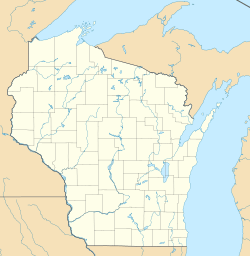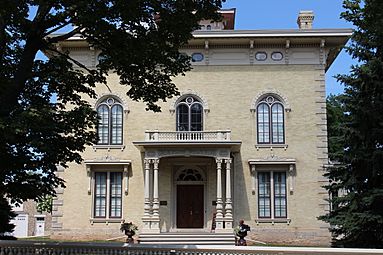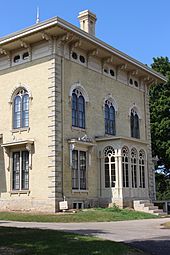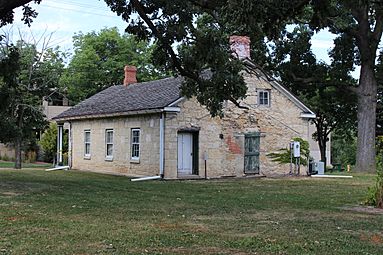Lincoln–Tallman House facts for kids
Quick facts for kids |
|
|
Tallman House
|
|
 |
|
| Location | 440 N. Jackson St., Janesville, Wisconsin |
|---|---|
| Area | 1.6 acres (0.65 ha) |
| Built | 1857 |
| Architectural style | Italian Villa |
| NRHP reference No. | 70000085 |
| Added to NRHP | October 15, 1970 |
The Lincoln–Tallman House is a beautiful old home in Janesville, Wisconsin. It was built in 1857 and has a special design called Italianate style. This house is famous because Abraham Lincoln once stayed there overnight, even before he became the President of the United States! Today, it's a museum where you can learn about life long ago.
Contents
A Special House in Janesville
Who Was William Tallman?
William Tallman was a lawyer who lived in the eastern United States. In the late 1840s, he bought a large amount of land, about 4,476 acres, in what was then Wisconsin Territory. Mr. Tallman was also an abolitionist. This means he strongly believed that slavery should be ended. He even gave speeches against slavery and helped enslaved people escape to freedom. His house in Rome, New York was a secret stop on the Underground Railroad, a network of safe houses for people escaping slavery.
Building a Dream Home
To keep a closer eye on his land, William Tallman moved his family to Janesville. In 1855, a local builder named George Barnes started constructing their new home. It was built on a bluff, which is a high, steep bank, overlooking the Rock River. The house was designed in the popular Italianate style, which often features low-pitched roofs, wide eaves, and tall, narrow windows.
The Tallman House was built with high-quality materials. It used special light-colored bricks called Cream City brick, and had fancy cast iron details around the windows. The doors were made of black walnut wood and had beautiful hand-carved designs. The house was very modern for its time! It had central heating, gas pipes for lights, and even running water. There were also walk-in closets with built-in drawers and an indoor bathroom. Building this amazing house first cost $33,000. After more work was finished in 1870, the total cost reached $42,000. The house is 60 feet tall and has six floors with 20 rooms!
The Tallman Family and Their Legacy
William Tallman continued to speak out against slavery after moving to Janesville. It's thought that his new house might have also been a stop on the Underground Railroad, but it's not known for sure if any escaped slaves stayed there. The Tallman family lived in the house from 1857 until 1915.
Years later, in 1950, the family gave the house to the city of Janesville. They had one condition: it had to be used as a public museum. This way, many people could visit and learn about its history.
When Lincoln Came to Visit
One of the most famous events at the Tallman House happened in October 1859. Abraham Lincoln visited Janesville from October 1st to 3rd, just a year before he was elected president. He had been in Milwaukee to speak at the Wisconsin State Fair. William Tallman drove to Beloit to invite Lincoln to come to Janesville and stay at his house after a speech there.
Lincoln gave a speech in Janesville on Saturday, October 1, 1859. That night, he left his boots outside his room, which was a common custom back then. But in the morning, his boots were gone! Because he felt embarrassed to leave his room in just his socks, he missed his train. So, Mr. Tallman invited him to go to church with his family. Lincoln then stayed another night and finally caught a train to Chicago on Monday, October 3, 1859. This visit to the Tallman House is the only time Abraham Lincoln is known to have stayed in a private home in Wisconsin.
A Historic Landmark Today
The Lincoln–Tallman House was officially added to the National Register of Historic Places on October 15, 1970. This means it's recognized as an important historical site. In 1995, it received a special award from the Victorian Society in America for its excellent preservation.
Today, the city of Janesville owns the house. The Rock County Historical Society operates it as a museum. When you visit, you can see what upper-class life was like in the late 1800s. More than 75% of the furniture and items in the house are original to the Tallman family, making it a truly authentic experience!






